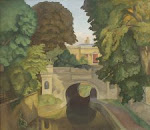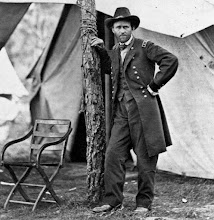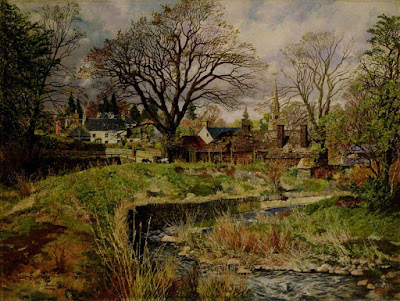A brief sigh of wistfulness passed through me. But I did not hear or feel "the strumble/Of the hungry river of death." (Hilaire Belloc, "From the Latin (but not so pagan.") The sight of the petals was too beautiful for that. We live in a World in which, each spring, the gutters of the streets are filled with the fallen petals of cherry blossoms.
The Drift of Petals
Firm-footed, small, she thrust my pram
its endless uphill, downhill way,
intent on country air.
I can recall our sheltering
beneath a hawthorn in a lane,
a dark cloud dowsed the sky.
And as we watched the slanting drops
a drift of petals settled on
my buttoned coverlet.
A wide road now that lane, with cars;
the hedges rooted out; the fields,
on either side, built-up.
And of that moment what survives
in these numb syllables, except
an old man's gratitude?
John Hewitt, Time Enough: Poems New and Revised (Blackstaff Press 1976).
John Aldridge (1905-1983), "Roofing a New House"
Later in the week, I walked past two large Yoshino cherry trees that stand in the front yard of a nearby house. The boughs of the trees extend over the sidewalk, creating a white-blossomed canopy at this time each year. The sidewalk is now covered with a carpet of petals. We live in a World in which, each spring, we can fill our cupped hands with the fallen petals of cherry blossoms.
Fallen Blossoms on the Eastern Hills
Cherry blossoms filling the ground, sunset filling my eyes:
blossoms vanished, spring old, I feel the passing years.
When blossoms were at their finest I neglected to call.
The blossoms did not betray me. I betrayed the blossoms.
Ishikawa Jōzan (1583-1672) (translated by Burton Watson), in Burton Watson, Kanshi: The Poetry of Ishikawa Jōzan and Other Edo-Period Poets (North Point Press 1990).
Gilbert Spencer (1892-1979), "From My Studio" (1959)
The camellia bushes along the north side of the house -- one with pink blossoms, one with white blossoms -- bloomed late this year, likely due to a winter that was longer, colder, and snowier than usual. But their petals are now falling, fallen, as well. The squirrels scamper over them.
A few years ago, a pair of doves nested in one of the bushes. In the mornings, I could hear their soft coos outside the window. I miss their company. But who knows what may happen? Spring has hardly begun.
Black and White
A blackbird flew to a hawthorn bush
and brushed a flutter of petals down;
they tumbled and turned like a flurry of snow
and settled slow on the waiting stone.
And, if that blackbird, all summer through,
could sing so long as there's light to see,
he would never fling a song as bright
as that lyric flight from the hawthorn tree.
John Hewitt, The Chinese Fluteplayer (1974).
Adrian Paul Allinson (1890-1959), "The Cornish April"








